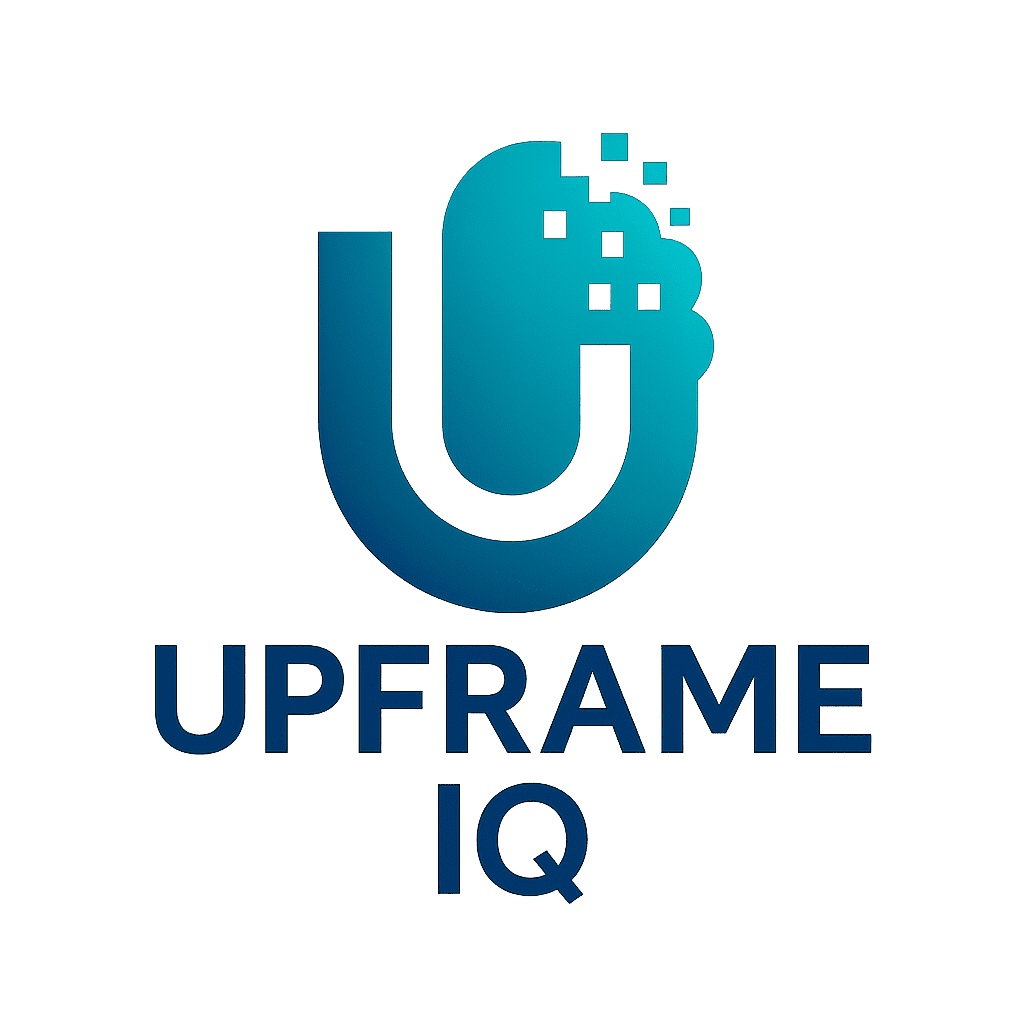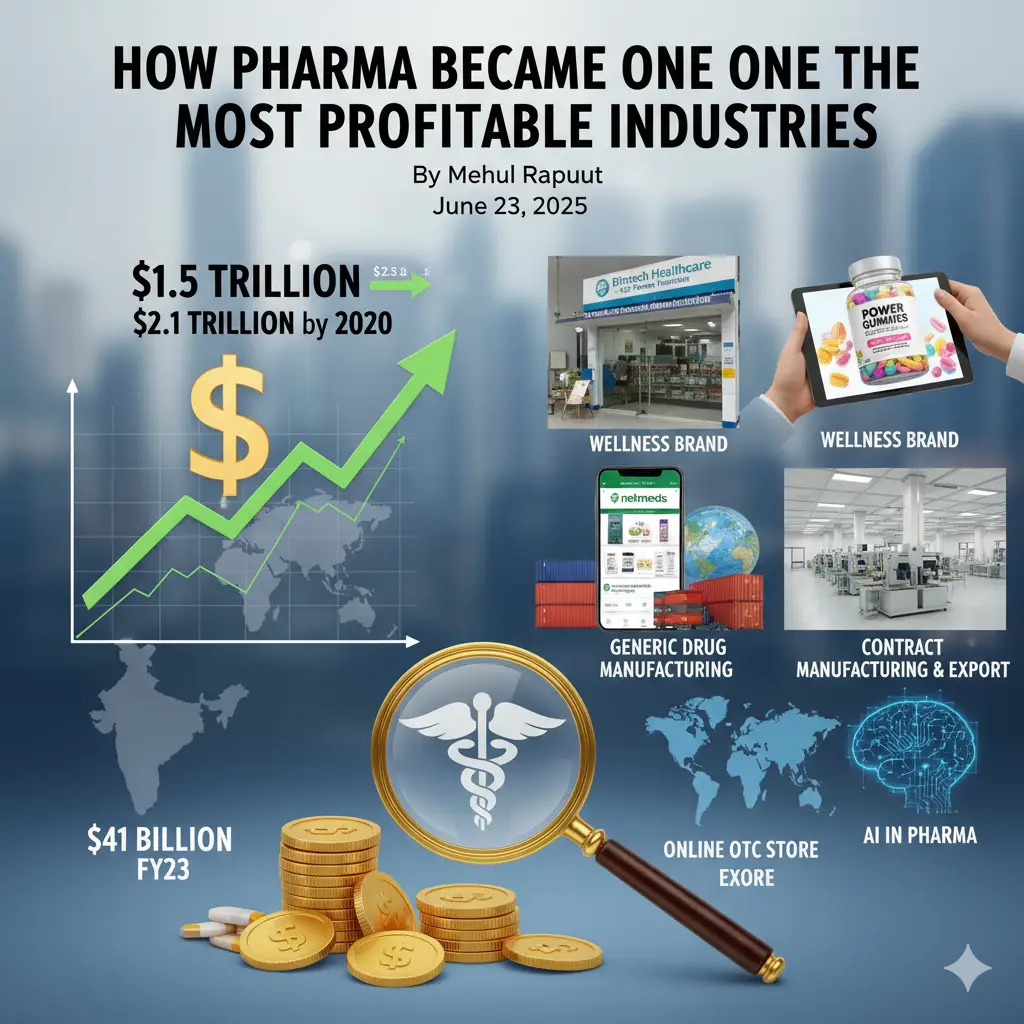The Golden Age of Pharmaceutical Entrepreneurship
You’re entering the industry at the perfect time. The global pharmaceutical market reached $1.48 trillion in 2022 and continues expanding at 6.1% annually. Unlike the tech sector’s volatility, pharma offers recession-resistant demand – people need medicines regardless of economic conditions.
The regulatory landscape has never been more entrepreneur-friendly. India’s liberalized FDI policies now allow 100% foreign investment in greenfield pharma projects. The government’s Make in India and Start-Up India initiatives provide tax incentives, fast-track approvals, and reduced compliance burdens.
Why now? Patent cliffs are creating massive generic opportunities. Digital transformation is opening new business models. The COVID-19 pandemic proved the industry’s resilience and profitability potential.
The six models we’ll explore represent different entry points based on your capital, expertise, and risk tolerance. Each offers distinct advantages for building profitable pharma business models that scale.
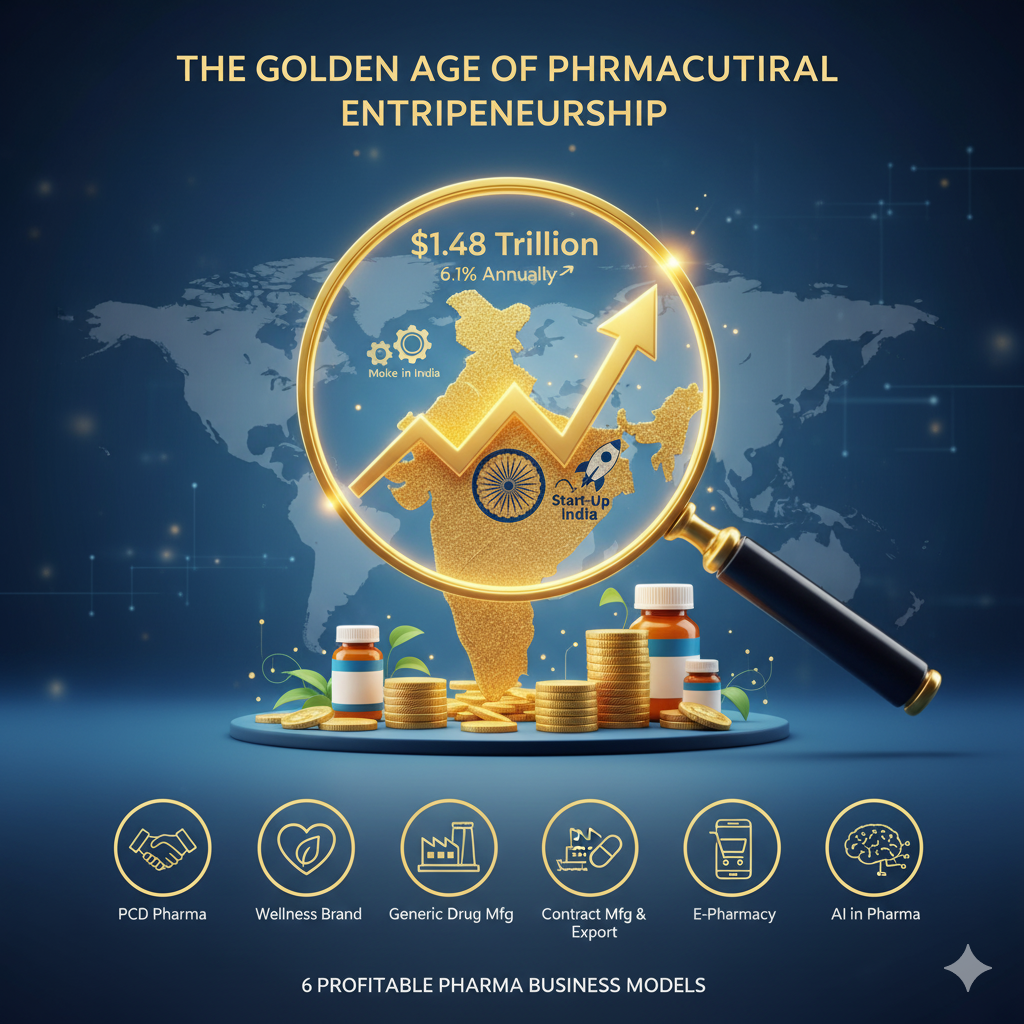
Contract Development and Manufacturing Organization (CDMO)
You become the behind-the-scenes engine powering other companies’ success. CDMOs manufacture drugs for pharmaceutical companies that lack production capacity or want to outsource non-core activities.
The market demand is explosive. Big pharma increasingly focuses on R&D while outsourcing manufacturing. Biotech startups need production partners but can’t justify building facilities. Mid-sized companies require overflow capacity during peak seasons.
Initial investment ranges from $2-10 million depending on your target complexity. You’ll need FDA-compliant facilities, quality control labs, and specialized equipment. The beauty lies in multiple revenue streams: manufacturing fees ($50-200 per batch), development services ($100-500K per project), packaging operations, and analytical testing.

Your competitive advantage comes from quality certifications and regulatory compliance. FDA registration, ISO certifications, and clean inspection records become your marketing materials. Scalability potential is enormous – successful CDMOs expand internationally or add therapeutic specialties.
Real-world insight: I’ve seen CDMOs start with basic tablet manufacturing and evolve into sterile injectable specialists, multiplying their per-unit revenue by 10x.
Success factors: Invest heavily in quality systems upfront. Regulatory violations can destroy years of relationship-building overnight. Build redundant capacity – your clients’ emergency orders become your highest-margin opportunities.
Generic Drug Manufacturing
You’re entering the goldmine of off-patent medications. Generic drugs represent 90% of prescriptions but only 20% of spending, leaving massive margin opportunities for efficient manufacturers.
The ANDA (Abbreviated New Drug Application) process requires proving bioequivalence to brand drugs. While complex, it’s far less risky than novel drug development. Manufacturing setup costs range from $5-25 million depending on dosage forms and therapeutic areas.
Profitable therapeutic niches include complex generics (modified-release formulations), hard-to-manufacture products (sterile injectables), and niche markets (ophthalmics, dermatology). Price competition is brutal in commodity generics, but specialized products maintain healthy margins.
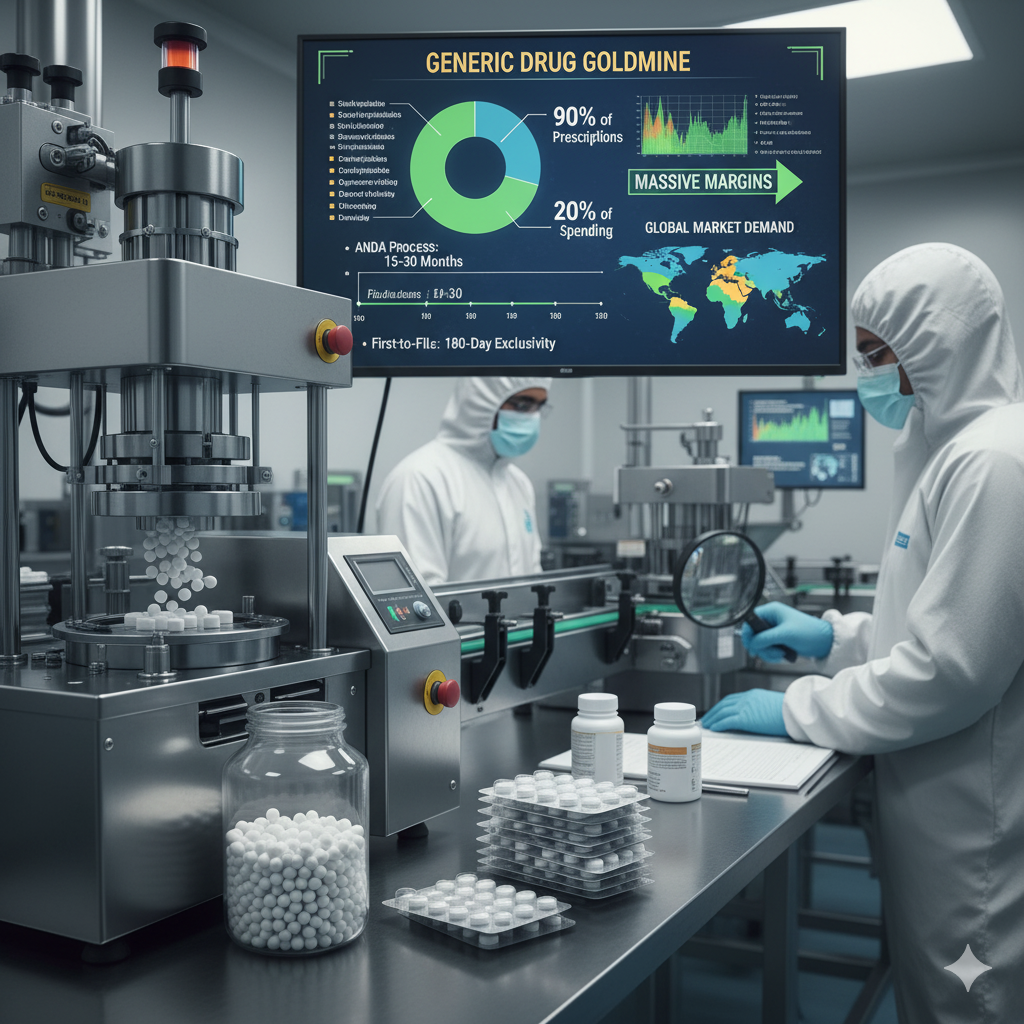
Key challenges center on regulatory hurdles and pricing pressure. FDA approval timelines average 15-30 months. First-to-file generic manufacturers enjoy 180-day exclusivity periods – the industry’s most lucrative opportunity.
Your competitive advantages emerge from cost efficiency and market timing. Establishing low-cost manufacturing while maintaining quality standards creates sustainable profits. Focus on therapeutic areas where you can achieve top-3 market positions.
Strategic approach: Start with 3-5 products in your expertise area. Build manufacturing excellence, then expand systematically. Many successful generic companies started with single products and built empires through disciplined execution.
Pharmaceutical Distribution and Supply Chain Solutions
You become the critical link connecting manufacturers to healthcare providers. Pharmaceutical distributors handle 90% of drug distribution in developed markets, creating stable, fee-based revenue models.
Licensing requirements vary by jurisdiction but typically include wholesale dealer permits, controlled substance registrations, and good distribution practice certifications. Initial investment ranges from $500K-5M depending on geographic scope and specialization levels.
Technology integration separates winners from losers. Cold chain management systems ensure temperature-sensitive products maintain efficacy. Tracking systems provide real-time inventory visibility. Automated warehouses reduce labor costs while improving accuracy.
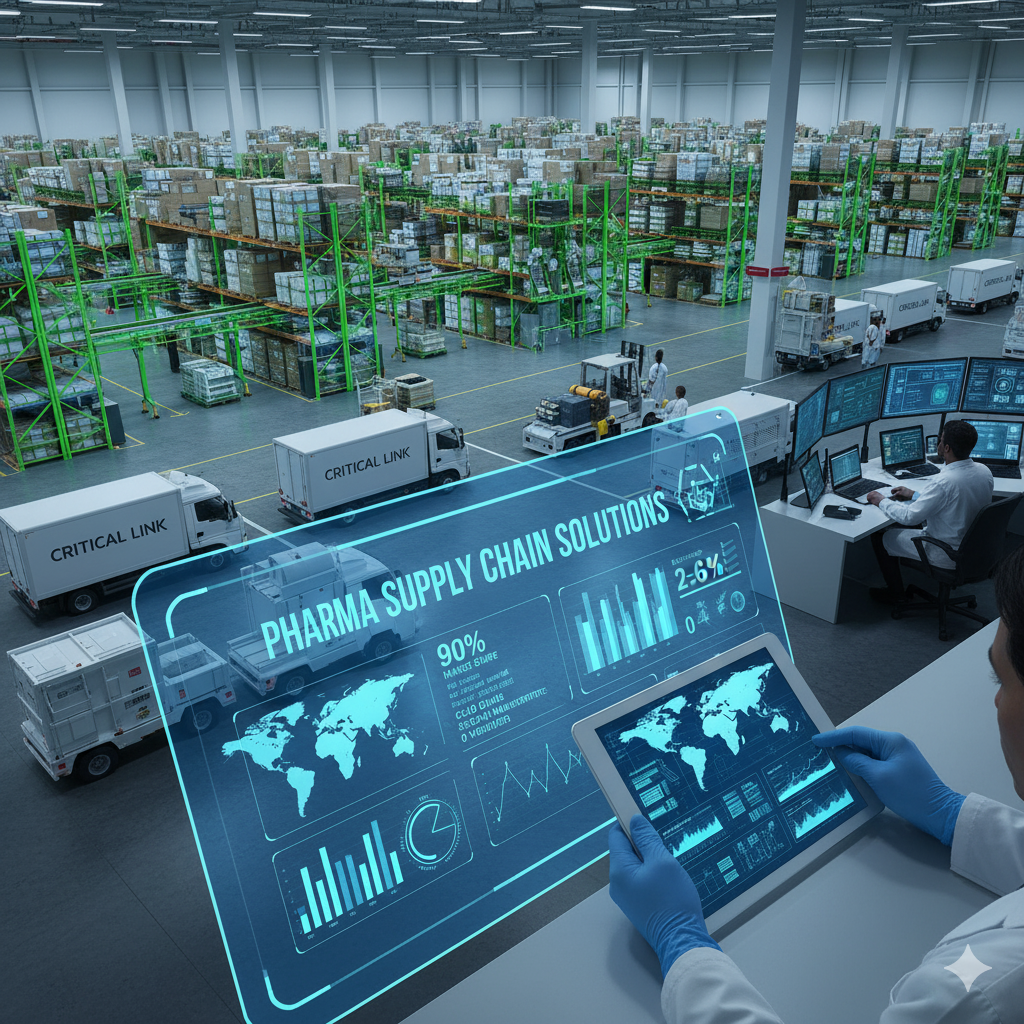
Revenue models include markup percentages (typically 2-6%), distribution fees, logistics contracts, and value-added services. Expansion opportunities exist in international markets, specialty medications (oncology, rare diseases), and direct-to-patient delivery.
The relationship-building aspect cannot be overstated. Manufacturers want reliable partners who understand their products. Healthcare providers need distributors who deliver consistently and handle emergencies professionally.
Strategic insight: Focus on therapeutic areas requiring specialized handling – cold chain products, controlled substances, or hospital-only medications command premium pricing.
Success factors: Invest in robust quality management systems. A single temperature excursion can destroy millions in inventory and your reputation. Build redundant supplier relationships and maintain safety stock for critical products.
Digital Health and PharmaTech Solutions
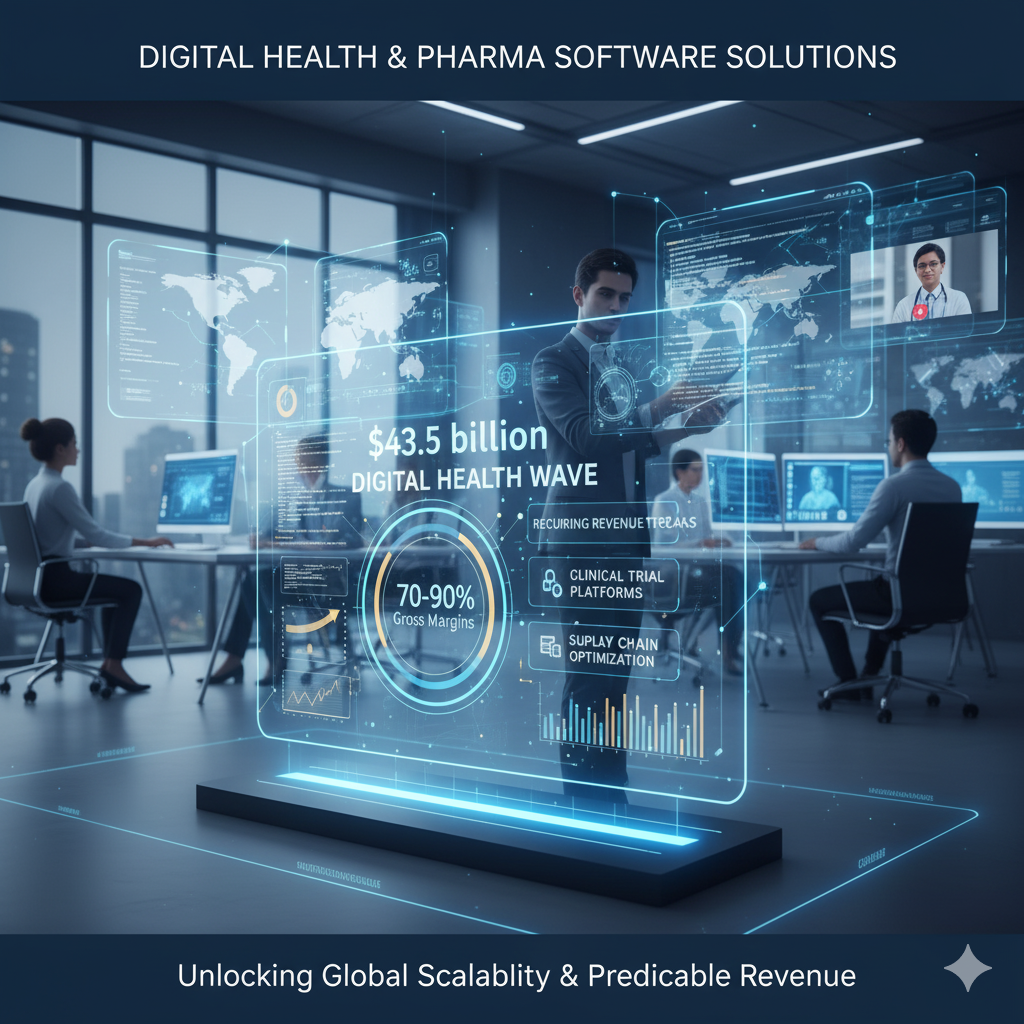
You’re riding the $43.5 billion digital health wave transforming pharmaceutical operations. Software solutions for pharmaceutical companies represent recurring revenue opportunities with global scalability potential.
High-demand areas include ERP systems tailored for pharma compliance, clinical trial management platforms, regulatory submission software, and supply chain optimization tools. Digital therapeutics and medication adherence platforms target direct patient engagement.
Development costs range from $100K for simple applications to $5M+ for comprehensive platforms. Technical expertise requirements are substantial – you need teams understanding both software development and pharmaceutical regulations.
Subscription-based revenue models provide predictable cash flows. SaaS pricing typically ranges from $10K-500K annually per client depending on functionality and user counts. Enterprise clients pay premium prices for validated, compliant solutions.
Telemedicine integration and e-pharmacy solutions represent explosive growth areas. Regulatory compliance remains critical – healthcare software faces strict validation requirements and data privacy regulations.
Scalability potential exceeds traditional pharma models. Software scales globally without manufacturing constraints. Successful platforms achieve 70-90% gross margins once development costs are recovered.
Strategic approach: Start with point solutions addressing specific pain points. Build credibility with smaller clients, then expand functionality for enterprise accounts. Focus on regulatory-heavy areas where compliance expertise creates barriers to competition.
Specialty and Niche Pharmaceutical Products
You target underserved therapeutic areas where limited competition allows premium pricing. Orphan drugs for rare diseases represent the industry’s highest margins – some products generate $100K+ annual revenue per patient.
Regulatory incentives support orphan drug development. FDA provides tax credits, fee waivers, accelerated approval pathways, and seven-year market exclusivity. European regulators offer similar benefits, creating global opportunities.
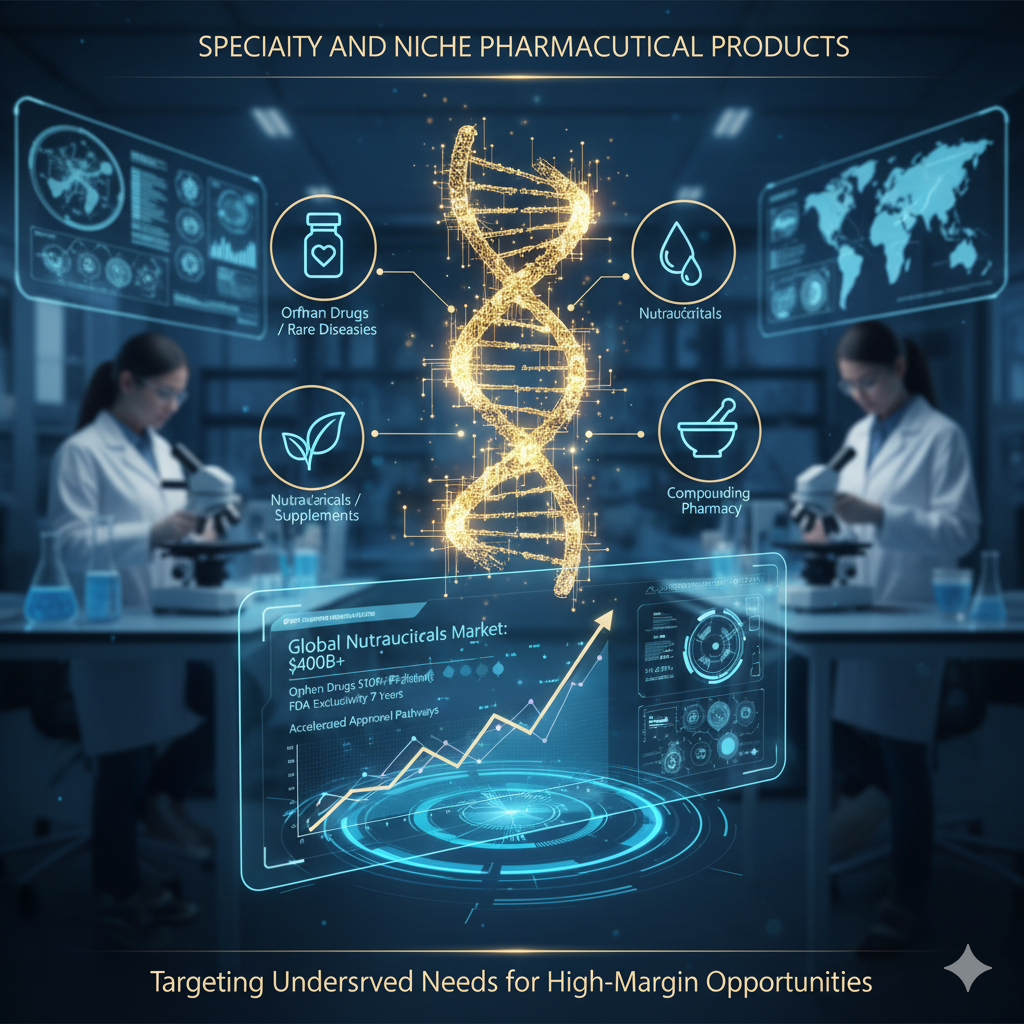
Nutraceuticals and dietary supplements offer lower regulatory barriers with faster market entry. The global nutraceuticals market exceeds $400 billion and grows 7% annually. Compounding pharmacy services provide personalized medicine solutions for unique patient needs.
Research and development investment strategies vary dramatically. Orphan drugs may require $50-500M development costs but generate billions in revenue. Nutraceuticals can launch with $1-10M investments but face intense competition.
Partnership opportunities with research institutions provide access to novel compounds and scientific expertise. University technology transfer offices actively seek commercialization partners for promising research.
Market insight: Focus on therapeutic areas with clear unmet needs and limited generic competition. Rare diseases, pediatric formulations, and geriatric-specific products offer sustainable competitive advantages.
Success factors: Build deep therapeutic area expertise. Regulatory pathway knowledge becomes your competitive moat. Establish key opinion leader relationships early – their endorsements drive adoption in specialty markets.
Pharmaceutical Consulting and Professional Services
You monetize pharmaceutical industry expertise through consulting and specialized services. This model requires minimal capital investment while generating high hourly rates and project fees.
Regulatory consulting represents the highest-demand area. Companies pay $200-500 per hour for experts navigating FDA submissions, international registrations, and compliance audits. Clinical research organization (CRO) services support drug development with study management, data analysis, and regulatory writing.
Quality assurance and validation services command premium pricing. Pharmaceutical companies outsource compliance functions to reduce internal staffing costs while accessing specialized expertise. Market access and reimbursement consulting helps companies optimize pricing and coverage strategies.
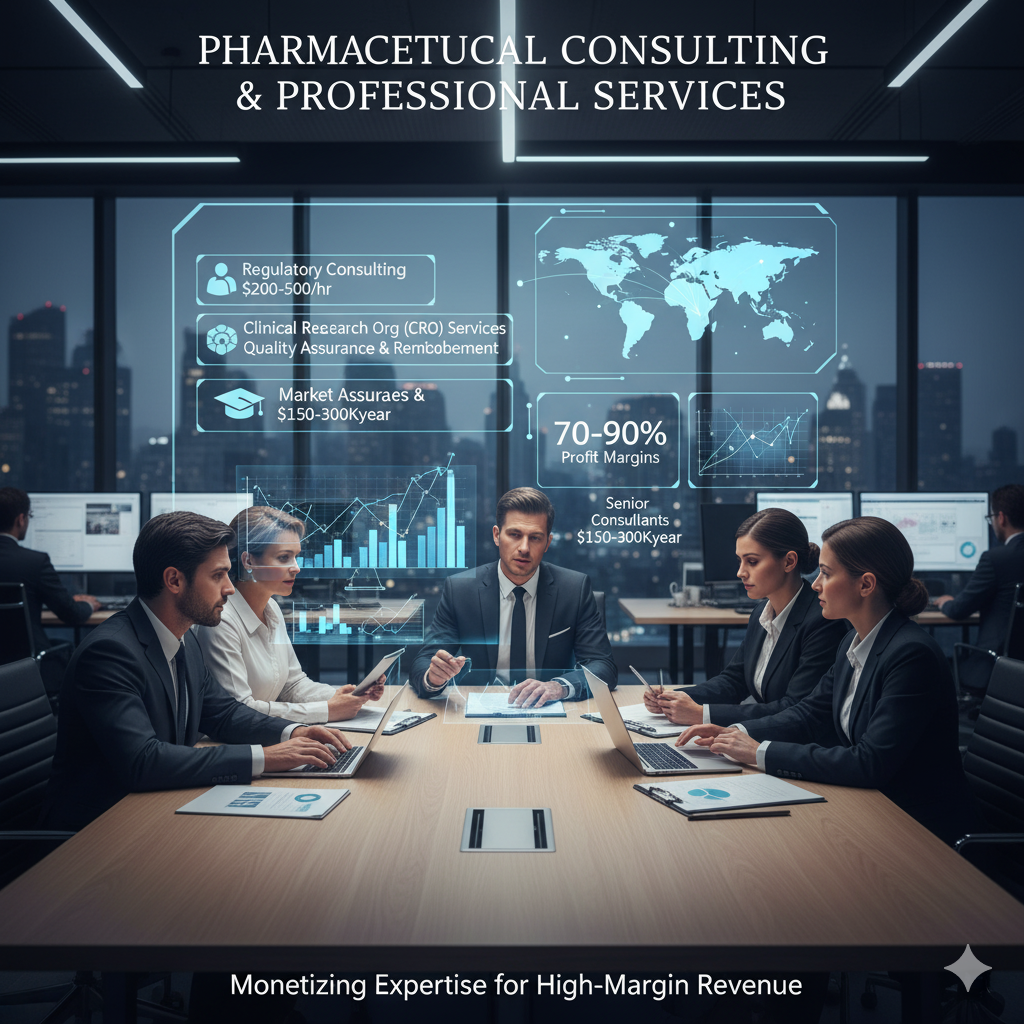
Training and education services provide recurring revenue through corporate workshops, certification programs, and online courses. The industry’s continuous training requirements create steady demand for qualified providers.
Building expertise requires significant pharmaceutical industry experience. Professional credentials from organizations like RAPS (Regulatory Affairs Professionals Society) enhance credibility. Specialized knowledge in areas like FDA validation or EU MDR compliance justifies premium rates.
Revenue potential scales with reputation and specialization depth. Senior consultants earn $150-300K annually. Consulting firms with 10-20 experts generate $5-15M annual revenue with 40-60% profit margins.
Strategic approach: Start with narrow specialization where you have deep expertise. Build case studies and client testimonials. Expand service offerings gradually while maintaining quality standards.
Essential Success Factors Across All Business Models
Pharmaceutical industry experience cannot be understated. Unlike tech startups where youth provides advantages, pharma rewards experience and domain knowledge. Regulatory complexity, long development timelines, and patient safety considerations require seasoned judgment.
Building the right team requires balancing technical expertise, regulatory knowledge, and business acumen. Successful pharma entrepreneurs surround themselves with experienced professionals who understand industry nuances.
Quality management systems form your operational foundation. Continuous improvement through regular audits, training updates, and process refinements maintains competitive advantages and regulatory compliance.
Relationship building with key stakeholders – regulators, healthcare providers, industry partners – creates sustainable competitive moats. Trust and reliability matter more in pharma than flashy marketing or disruptive innovation.

Risk management strategies must account for regulatory changes, competitive threats, and market access challenges. Diversification across products, markets, or services reduces dependence on single revenue sources.
Entrepreneurial insight: Treat regulatory compliance as a competitive advantage, not a cost center. Companies that excel at quality and compliance win long-term while competitors struggle with violations and delays.
Staying current with industry trends, regulatory updates, and technological advances requires continuous learning investment. Professional development and industry conference participation provide invaluable networking and knowledge updates.
Navigating Regulatory Landscapes and Government Support
FDA regulations represent the gold standard for pharmaceutical quality and safety. Understanding 21 CFR requirements for your specific business model prevents costly violations and delays. International expansion requires mastering ICH guidelines and regional regulatory differences.
State and local licensing varies significantly by location and business type. Wholesale dealer permits, controlled substance registrations, and professional licensing requirements must be secured before operations begin.
Government incentives significantly impact startup economics. Tax breaks for pharmaceutical R&D, manufacturing in designated zones, and export promotion schemes improve project returns. Grant programs from NIH, NSF, and state economic development agencies provide non-dilutive funding.
Intellectual property protection strategies require early planning. Patent applications, trade secrets, and trademark registrations protect competitive advantages. Working with specialized IP attorneys familiar with pharmaceutical patents prevents costly mistakes.
Timeline planning for regulatory approvals affects cash flow projections and market entry strategies. FDA approval processes range from 6 months (510K medical devices) to 12+ months (drug applications). International harmonization through simultaneous submissions reduces overall timelines.
Working with regulatory consultants accelerates approval processes while reducing internal staffing requirements. Experienced regulatory affairs professionals understand agency preferences, common pitfalls, and expedited pathway opportunities.

Financial Planning and Investment Strategies
Initial capital requirements vary dramatically across profitable pharma business models. Software solutions may launch with $500K while manufacturing facilities require $10-50M investments. Accurate financial projections require understanding regulatory approval timelines and market penetration rates.
Funding sources include angel investors with pharmaceutical backgrounds, specialized pharma-focused venture capital, government grants, and strategic partnerships. Due diligence processes emphasize regulatory compliance, market opportunity validation, and team expertise assessment.
Revenue projections must account for long development timelines and binary approval outcomes. Conservative scenario planning with delayed approvals and competitive entries prevents cash flow crises. Profitability timelines typically extend 3-7 years depending on business model complexity.
Cash flow management during regulatory approval periods requires careful planning. Milestone-based funding aligned with regulatory achievements reduces investor risk while providing operational capital. Revenue diversification through multiple products or services provides stability during approval delays.
Exit strategies include strategic acquisitions by larger pharmaceutical companies, private equity sales, or public offerings. Business valuation typically uses revenue multiples (3-8x) or discounted cash flow models incorporating regulatory risk factors.
Insurance and risk mitigation planning must address product liability, professional indemnity, and business interruption coverage. Pharmaceutical-specific insurance protects against regulatory violations, product recalls, and clinical trial adverse events.
Your Pharmaceutical Empire Awaits
Choosing the right business model depends on your experience level, available capital, and risk tolerance. Manufacturing models require substantial investment but offer scalable returns. Service-based models provide faster market entry with lower capital requirements.
Building for long-term sustainability means investing in quality systems, regulatory compliance, and professional relationships from day one. Short-term cost cutting in these areas creates expensive problems later.
The patient-focused mission provides meaning beyond financial returns. You’re not just building a business – you’re improving healthcare outcomes and potentially saving lives. This purpose attracts talented employees and supportive stakeholders.
Future trends favor entrepreneurs who understand digital transformation, personalized medicine, and global market access. Emerging opportunities in areas like gene therapy, digital therapeutics, and precision medicine offer first-mover advantages.
Taking the first step requires thorough market research, financial planning, and team building. Start with deep preparation rather than rushing to market. The pharmaceutical industry rewards careful planning and disciplined execution over rapid iteration.
Is the pharma industry profitable? Absolutely – for entrepreneurs who understand its unique requirements and invest appropriately in expertise, quality, and compliance. Your pharma business in India or globally can achieve exceptional returns while making meaningful social contributions.
The opportunities exist. The regulatory environment supports entrepreneurship. The market demands innovation and efficiency. How to start a pharma business begins with choosing your model and taking action.
Your pharmaceutical empire awaits. The question isn’t whether opportunities exist – it’s whether you’ll seize them.
Frequently Asked Questions
- What is the minimum capital required to start a pharmaceutical business?
Capital requirements vary dramatically by business model. Consulting services can start with $50-100K for professional certifications and basic infrastructure. Software solutions require $200K-2M depending on development complexity. Distribution businesses need $500K-5M for licensing, inventory, and facilities. Manufacturing operations require $5-50M based on product complexity and production capacity.
2.How long does it take to get regulatory approvals?
Timeline expectations depend on your business type and target markets. FDA drug applications average 10-15 months for generic drugs and 12-18 months for new chemical entities. Medical device approvals range from 3-6 months (510K) to 12+ months (PMA). International approvals add 6-24 months depending on regulatory harmonization levels. Plan for longer timelines and budget accordingly.
FAQs
3. Do I need a pharmacy or medical degree to start a pharma business?
Educational requirements depend on your chosen business model and local regulations. Manufacturing and distribution typically require qualified person designations – often pharmacists or chemical engineers. Consulting services value industry experience over specific degrees. Software companies need technical expertise but not healthcare credentials. Consider hiring qualified professionals or partnering with credentialed individuals to meet regulatory requirements.
5.How do I find reliable manufacturing partners or suppliers?
Due diligence processes should evaluate FDA inspection histories, quality certifications, and financial stability. Visit facilities personally and audit quality management systems. Request client references and verify regulatory compliance records. Evaluate backup suppliers to prevent single-source dependencies. Consider geographic diversification to manage political and natural disaster risks.
6.What government programs support pharmaceutical startups?
Federal programs include SBIR/STTR grants from NIH and NSF, FDA’s emerging technology programs, and tax credits for R&D activities. State programs vary but often include manufacturing incentives, export promotion support, and incubator facilities. India’s specific programs include Make in India benefits, startup tax exemptions, and fast-track regulatory approvals. Consult with economic development agencies and specialized consultants to identify applicable programs.
